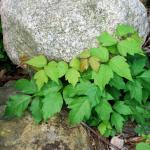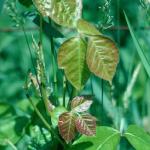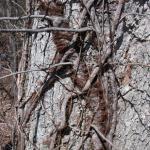Poison Ivy
 One of the hazards for gardeners and landscape professionals is coming in contact with Eastern Poison Ivy, Toxicodendron radicans. Taxonomically, poison ivy is a member of plant family Anacardiaceae, also known as the cashew or sumac family. Other notable members of this family includes cashew, pistachio, and mango
One of the hazards for gardeners and landscape professionals is coming in contact with Eastern Poison Ivy, Toxicodendron radicans. Taxonomically, poison ivy is a member of plant family Anacardiaceae, also known as the cashew or sumac family. Other notable members of this family includes cashew, pistachio, and mango
Description and range
Native to New England, poison ivy is commonly found growing in a many types of habitats, including woodland edges, gardens, landscapes, roadsides, and riverbanks. It grows in areas from partial shade to full sun. Poison ivy is also adapted to a wide range of soil moisture conditions and commonly thrives is moist riparian areas as well as very dry and impoverished soils.
 “Leaflets three, let it be” sums up the most easily identified characteristic of poison ivy - its three leaflets. The middle leaflet of the three tends to be larger than the two on either side, but each measures from 2 to 4 inches in length. At maturity, the leaflets are dull or glossy green. New leaf shoots in spring tend to be droopy and reddish-green in color while in fall, the leaflets turn a vivid orange, red and yellow. The edges of a leaflet may be irregularly toothed, smooth, or lobed. Poison ivy produces clusters of small yellow-green flowers in the spring that originate in the axils of leaves, then later in the season, small green berries that turn light gray to white. The plant is known for its wildlife value and the berries are eaten by birds and other animals which help disperse the seed.
“Leaflets three, let it be” sums up the most easily identified characteristic of poison ivy - its three leaflets. The middle leaflet of the three tends to be larger than the two on either side, but each measures from 2 to 4 inches in length. At maturity, the leaflets are dull or glossy green. New leaf shoots in spring tend to be droopy and reddish-green in color while in fall, the leaflets turn a vivid orange, red and yellow. The edges of a leaflet may be irregularly toothed, smooth, or lobed. Poison ivy produces clusters of small yellow-green flowers in the spring that originate in the axils of leaves, then later in the season, small green berries that turn light gray to white. The plant is known for its wildlife value and the berries are eaten by birds and other animals which help disperse the seed.
 Poison ivy is a woody perennial and can be found in different forms. It may grow as a low, spreading shrub with fine stems. It may also grow as an upright, three foot tall shrub, or it may grow as a woody vine. Vines attach to tree trunks by way of aerial roots that make the vine look like a fuzzy rope. Images and additional identification notes for poison ivy can be found on the UMass Extension Weed can be found at: http://extension.umass.edu/landscape/weeds/toxicodendron-radicans
Poison ivy is a woody perennial and can be found in different forms. It may grow as a low, spreading shrub with fine stems. It may also grow as an upright, three foot tall shrub, or it may grow as a woody vine. Vines attach to tree trunks by way of aerial roots that make the vine look like a fuzzy rope. Images and additional identification notes for poison ivy can be found on the UMass Extension Weed can be found at: http://extension.umass.edu/landscape/weeds/toxicodendron-radicans
Rash, itch and blisters, OH MY!!!! The American Academy of Dermatology reports about 85 percent of people who come in contact with poison ivy will develop a rash. An individual that considers themselves a member of the “lucky 15 percent club” and boldly boasts “I do not get poison ivy” is never guaranteed that this will always be the case. Sensitivity to poison ivy can change at any point in one’s life. An allergic reaction is a response to a plant oil call urushiol. Urushiol is found in all parts of the plant and is released whenever the plant is crushed or bruised. When urushiol oil contacts skin, it can cause an allergic reaction, ranging from reddening and swelling, to blistering or open sores. Reactions will vary depending upon the sensitivity of the individual.
Contrary to popular belief, the rash caused by poison ivy is not spread by contact with open sores. However, the tacky oil is persistent and can be spread indirectly by contact with pets, garden tools, garden gloves, shoes, golf balls, or any other object that has come in contact with a bruised poison ivy plant. Urushiol oil also persists in dormant and dead plants. Poison ivy should never be burned since the smoke can carry the oil and cause problems to anyone inhaling the smoke. The use of a string trimmer or chainsaw can result in the splattering of urushiol and cause a severe rash.
Protect yourself from poison ivy. The best way to protect yourself from poison ivy is to be able to recognize the plant and either stay away or take the necessary precautions to limit exposure.
Working Near Poison Ivy?
- Consider wearing clothing that covers as much of your skin as possible. Long-sleeved shirts, pants, hats, heavy rubber gloves, socks, and closed-toe shoes are advised.
- If you suspect that you came in contact with poison ivy, soap will be your best friend. Rinsing your skin with cool, soapy water or rubbing alcohol within about an hour of touching poison ivy may remove the urushiol and help you avoid a rash — or at least make it less severe. You'll also need to wash anything else that's come in contact with the plant. Urushiol can remain potent for years, so skipping the cleanup could result in a rash at a later point.
- Over-the-counter products may provide relief of mild case of poison ivy. Consult a physician if the rash is widespread and/or severe. Severe cases may include trouble breathing or swallowing, swelling of face (especially eyes and mouth), and genitals.
Managing Poison Ivy
When attempting to control poison ivy, one should dress appropriately as discussed above. Physical or mechanical strategies are not encouraged for the control of poison ivy due to the risk of allergic reaction. An application of an herbicide will control plants and reduce the risk of an allergic reaction. Herbicides that contain the active ingredient glyphosate and triclopyr will effectively control poison ivy. Grasses are tolerant of triclopyr, therefore the use of triclopyr would be selected over glyphosate in areas where the product may contact lawn grasses. Exercise caution around broadleaf plants, as both herbicides will harm or injure these plants. Application should be made after full leaf expansion and when the plant is actively growing. In New England, the application period is late June through early September. It is important to note that the urushiol is active in dead plant material for several years. Unknowingly digging and hand-pulling poison ivy roots can result in severe dermatitis on unprotected hands.
Written by: Randy Prostak
Revised: 08/2016